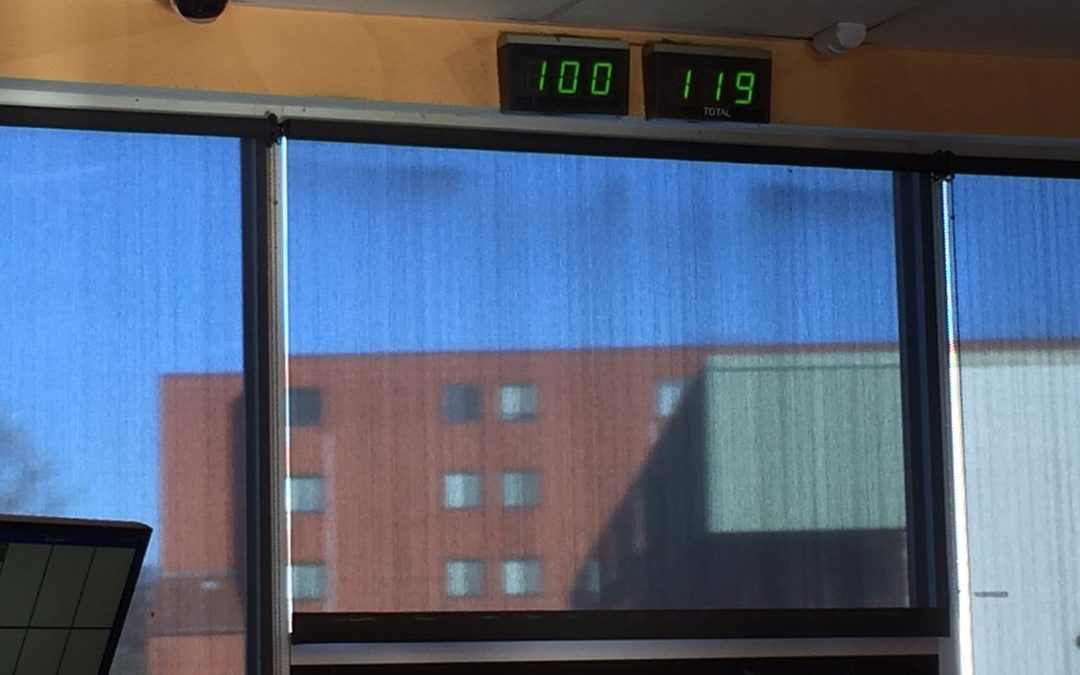 Sunday morning on my way to church, I stopped by my local Dunkin Donuts to grab a coffee and a bite to eat. As I was waiting for my order, I noticed something interesting right above the drive-through window – an LED digital display showing two numbers (100 and 119 – see the picture to the left).
Sunday morning on my way to church, I stopped by my local Dunkin Donuts to grab a coffee and a bite to eat. As I was waiting for my order, I noticed something interesting right above the drive-through window – an LED digital display showing two numbers (100 and 119 – see the picture to the left).
As I watched the DD team prepare orders, the display on the right seemed to be counting seconds. The left LED displayed the number “100” which I guessed was the number of customers served that day. It was about 8am so that seemed right. The store opened at 4:30am so they were serving about 28 customers an hour. Each customer took about 2.14 minutes to serve.
Once the car at the front of the line received their order and pulled away, the second LED display reset to 60 and started counting again. That meant the next car in line had been waiting 60 seconds since placing their order.
I thought this was pretty interesting. The management of Dunkin Donuts must think the time it takes to deliver an order is pretty important. It’s so important that DD has built a system to measure it. The more orders they can push through the more money each DD franchise can make, but HOW MUCH more?
I am sure that DD is reviewing this number on a weekly, even daily basis. If this metric/KPI drops too low, the management works with the team to adjust. They spend time digging into their processes so they can shorten the time it takes to fulfill an order.
Is this really a BIG deal? Let’s do a little math…
Here are my assumptions (feel free to push back on any of these)
- The busy time for DD is between 7am and 8am so let’s focus on this one hour period
- The average order is $6.00 (a coffee and a bacon egg and cheese on an English muffin)
- The average time to fulfill and order is 120 seconds
This means if DD drive-through employees can fulfill 30 orders per hour, DD will make $180 in revenue.
What if they could shorten the time it takes to fulfill an order from 120 seconds to 90 seconds? That would mean they could fulfill 40 orders or generate $240 in revenue per day. If the team could optimize that 1 hour period every day for a year, that’s an incremental $21,900 per year! That’s for just optimizing that 1 hour! WOW!
Here’s the math:
current state – 30 orders * $6 * 365 days = $65,700
future state – 40 orders * $6 * 365 days = $87,600
What else could the employees do to generate more revenue?
What if the DD employees were trained to up sell each customer by $1? What impact would that have?
current state – 30 orders * $6 * 365 days = $65,700
future state – 40 orders * $7 * 365 days = $102,200
How could DD really engage their employees in the improvement process?
What if DD let their employees know the goals? And what if DD gave their employees a piece of that incremental revenue? What it the employees could optimize 2 hours out of the day? That would result in $73,000 in incremental revenue! DD could “afford” to give those employees a healthy bonus and still be ahead of the game.
Don’t think measuring the right things in your business can have a huge impact? This one DD franchise just increased their revenue by $73,000 by measuring one thing – the right thing and optimizing it.
But I don’t own a DD franchise…
But I don’t own a DD franchise you say. My business is different you say. I guarantee you that there is a process in your business that could be optimized, either by increasing the revenue generated by the employees you have OR by reducing the cost and thereby increasing your profit. Dig deeper. It all starts with tracking the correct metrics.
Need Help Measuring the Right Things in Your Business?
Execute faster by signing up to attend a FREE 30 minute demo of Envisionable – our business execution platform.
